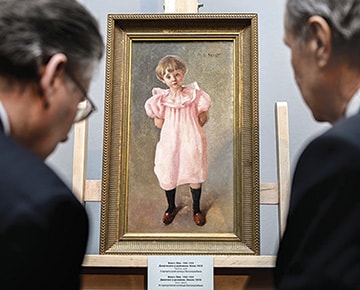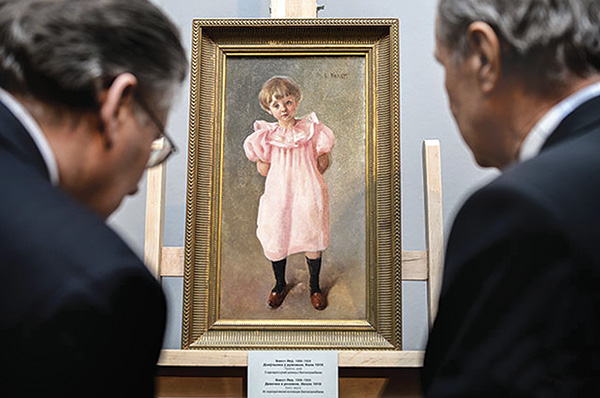
Leon Bakst’s Child in Pink canvas presented at National Art Museum
Recently, the National Art Museum hosted a presentation of Belgazprombank’s latest purchase: Leon Bakst’s Child in Pink. It is the bank’s eighth corporate collection work by Bakst to be showcased to the public.
“We know little of it so far. Most probably, it’s not a commercial family portrait,” comments the Chairman of Belgazprombank’s Board, Victor Babariko. “It shows a naïve home scene, in which a girl has probably returned from a walk. Her stockings are poor, and it’s as if she has been caught unexpectedly, and asked to pose. It was drawn in the early 20th century and we came upon it by accident. One of our old partners — being aware of our Parisian school collection — suggested that we purchase the canvas. When the exhibition was just launching in Minsk, we were negotiating. I felt it was a pearl not only in Bakst’s artistry but in our collection. We have no other similarly warm, interesting works.”
The exhibition features over 200 artworks, by Leon Bakst and his contemporaries: Alexandre Benois, Mikhail Vrubel, Konstantin Korovin, Boris Kustodiev, Isaak Levitan, Mikhail Nesterov, Kuzma Petrov-Vodkin, Zinaida Serebryakova, Valentin Serov and others. Bakst’s artistry is represented by over 40 pieces, from private, corporate and museum collections of Belarus, Latvia, Lithuania, Poland and Russia.
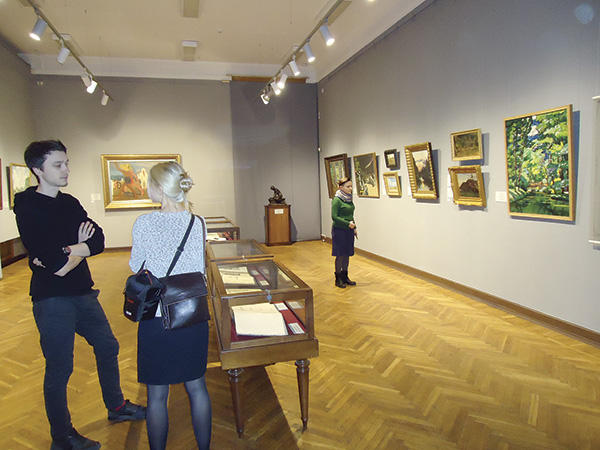
The picture was presented by the National Art Museum’s General Director, Vladimir Prokoptsov, and Victor Babariko. The latter explains, “This small masterpiece is a jewel in our collection and an additional impetus for attracting attention to Leon Bakst’s show. We’re on the edge of new, interesting discoveries regarding this picture. Art experts have already launched a discussion on the identity of the girl depicted. All are passionately studying the appearance of children from the early 20th century. It’s quite possible that the canvas depicts one of Bakst’s sons. We can assert for sure that the child is a family member. In any case, this work is unique within the collection, both spiritual and homely. It was painted for ‘domestic’ purposes and this is its major value.”
The presentation gathered representatives of artistic unions, painters, journalists and art critics, as well as heads of the Bolshoi Opera and Ballet Theatre, its chief ballet master and leading ballet soloists.
A curator of Belgazprombank’s corporate collection and the author of Leon Bakst: Life by Firebird’s Feather, Vladimir Schastny, acted as the show guide, explaining that Child in Pink was purchased from a French collector in Paris. It was painted by the globally famous artist, whose anniversary is among UNESCO’s Memorable Dates Calendar this year.
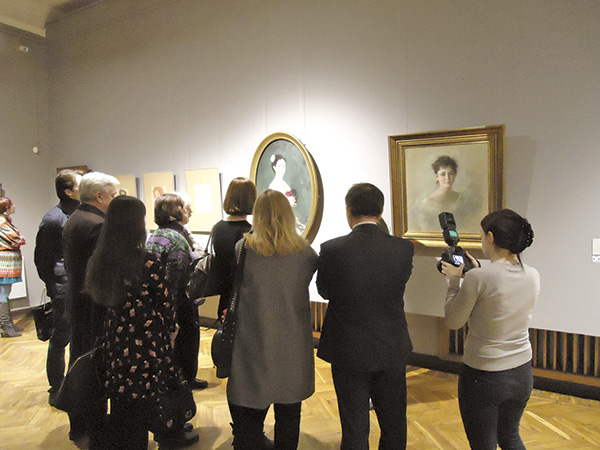
Always many visitors at the exhibition
National Art Museum experts comment that the portrait lacks the pageantry usual in commercial pieces, being characterised by ingenious sincerity and a cosy ‘family feel’. The Head of the National Art Museum’s Department of Scientific-Enlightening Activity, Nadezhda Usova, tells us, “This purchase is valuable, as Belarus’ state collection lacks a single pictorial work by the artist. The National Art Museum keeps just three such portraits by Bakst: lithographies depicting artists F. Malyavin and I. Levitan, and writer Z. Gippius. Child in Pink not simply supplements our modern views on Bakst as a wonderful portrait painter but is also a valuable contribution to Belarus’ early 20th century fine arts.”
The picture is Belgazprombank’s eighth work by Bakst and the bank’s collection is already the richest in Central and Eastern Europe in terms of numbers of original easel works by the famous painter. “When we were opening our show, we felt dissatisfied, knowing that we had a masterpiece, a pearl in our hands, but were unable to show it to the public,” Mr. Babariko says.
“The work is interesting not only for its pictorial features. Bakst is more than a realist; he is an interpreter, depicting the child not in a secular fashion or stately — as any other artist would have done. He depicted the child’s character, for us to ‘read’. The features come to the fore, so we feel we can understand the child’s nature,” explains Ms. Usova.
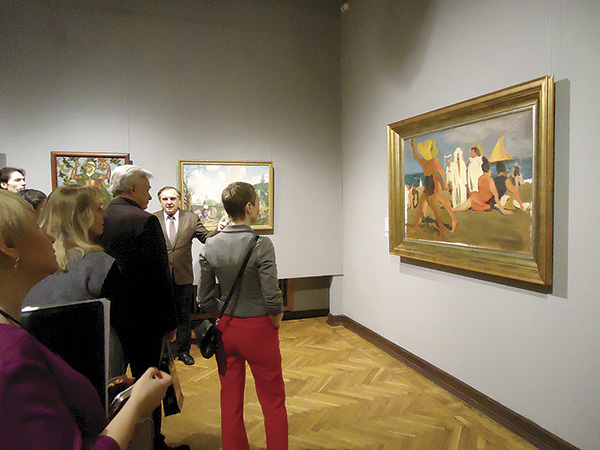
Better to see Bakst with a curator
Museum curators stress that the bank is making significant and important efforts to acquire works by Belarus-born artists for the country. “Museums lack necessary funds to do so,” adds Ms. Usova. The bank never comments on prices paid but Bakst’s Bathers on the Lido: Venice, bought by the bank last year, was being advertised at $1m.
According to Mr. Babariko, Belgazprombnk plans to buy an edition by Frantsisk Skorina this year, in addition to a work by Chaim Soutine. “Our collection lacks a beautiful Soutine. We are slowly yet confidently investigating this idea and already have some plans. However, I’m not sure we’ll be lucky enough this year. Soutine’s pictures are expensive and I’m not sure we’ll see prices cut as much as we’d like them to be,” he adds.
The Minsk exhibition is devoted to the 150th anniversary of the birth of famous artist and stage decorator Sergey Dyagilev, co-author of the famous Russian Seasons. The National Art Museum is to host Time and Art of Leon Bakst until April 17th. The exhibition will then move to Vilnius City Gallery (Lithuania) and then to Riga’s Bourse Museum (Latvia).
MT REFERENCE:
Leib-Chaim Bakst (Rosenberg) was born in Grodno in 1866. After graduating from the St. Petersburg Academy of Arts and Parisian art schools, he became a co-founder of the Mir Iskusstva (World of Art) legendary art association. He was a prominent portraitist, painter and art designer who revolutionised theatrical design, for sets and costume. Due to his close co-operation with ballet impresario Sergey Dyagilev, Bakst became a world-known painter, creating luxurious sets and costumes for the Russian Seasons’ ballet performances in Paris. He died in 1924 and was buried in France.
Leon Bakst’s works are kept by the world’s most prestigious museums, their prices setting records at global auctions.
By Veniamin Mikheev









